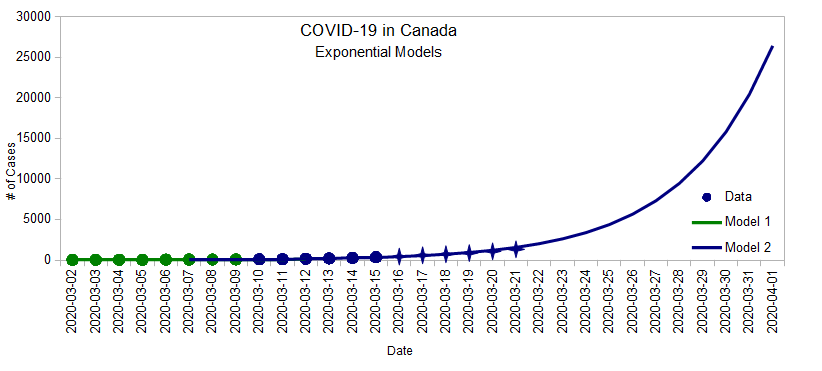This is an old revision of the document!
Table of Contents
COVID-19 Spread
I'm not an epidemiologist, doctor, or any kind of expert on the subject so take this with a grain of salt.
One of the key messages from today's PM announcement is that things will get worse before they get better. I wanted to have a sense of the rate at which COVID-19 is spreading in Canada, so I made a graph, and did some math.
First, I got the data from https://www.covid-19canada.com, plotted them on a graph, and tried to use a basic exponential model to extract some key information.
| Date | Count |
|---|---|
| 2020-03-02 | 27 |
| 2020-03-03 | 27 |
| 2020-03-04 | 33 |
| 2020-03-05 | 37 |
| 2020-03-06 | 48 |
| 2020-03-07 | 60 |
| 2020-03-08 | 64 |
| 2020-03-09 | 77 |
| 2020-03-10 | 95 |
| 2020-03-11 | 117 |
| 2020-03-12 | 157 |
| 2020-03-13 | 201 |
| 2020-03-14 | 254 |
| 2020-03-15 | 342 |
There seems to be two different patterns in this two-week period:
- Between March 2 and March 10 (ish) (green line), the number of cases was doubling every 4.1 days.
- Since March 10 (ish) (blue line), the number of cases has been doubling every 2.7 days.
If the blue pattern continues until the end of the week, we should have close to 1600 cases by the end of Saturday1):

In reality, the spread of the infection follows a curve like the Logistic Function. The beginning looks like an exponential, but the end flattens out, which is what the news keeps referring to when they say that social distancing and proper hygiene helps “flattening the curve” more quickly.

Here's a good video that explains this sort of math and why being able to think in exponential term is important for non-linear systems such as this one.
If you like this sort of thing, I did something similar in 2011 about the atmospheric CO2 levels, and then updated the data seven years later to see how my model stacked up. It might be time for a new update soon...

